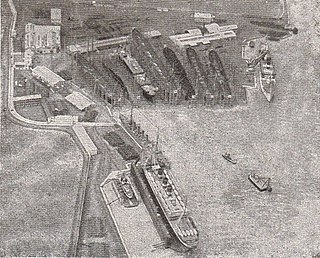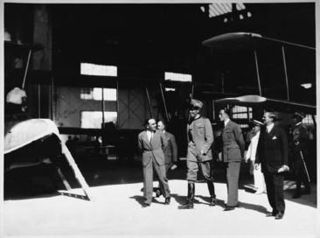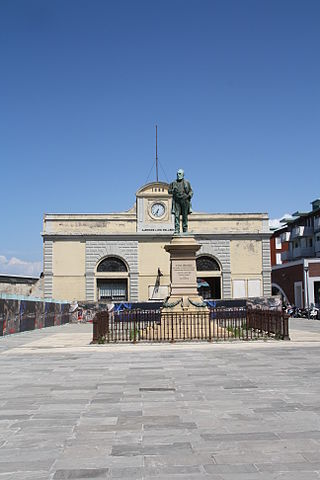Stabilimento Tecnico Triestino (STT) ("Technical Establishment of Trieste") was a private shipbuilding company based in Trieste from the mid-19th to early 20th century, and the most important naval shipbuilding firm of the Austro-Hungarian Empire.
The Ariete-class torpedo boats were a group of destroyer escorts built for the Italian Navy during World War II. They were enlarged versions of the Spica-class torpedo boats and designed to escort convoys to North Africa. Of the 42 units planned, sixteen ships were eventually ordered but only one was completed by the time of the armistice, Ariete, built in the Sestri Ponente shipyards and commissioned on 5 August 1943. The namesake ship was also the only one to survive the war. After the war it was ceded to the Yugoslav Navy (1949), and renamed Durmitor.

CANT was an Italian aviation company which originally specialised in building naval aircraft, formed in 1923 as part of the CNT. The company produced a number of designs for the Italian military, but ceased operations in 1944.

Giuseppe Garibaldi was an Italian Duca degli Abruzzi-class light cruiser, that served in the Regia Marina during World War II. After the war she was retained by the Marina Militare and upgraded. She was built by CRDA, in Stabilimento Tecnico Triestino shipyard Trieste and named after the Italian general Giuseppe Garibaldi.

Associazione Sportiva Dilettantistica Unione Fincantieri Monfalcone is the main Italian association football club in Monfalcone. In the football season 2016-2017 it has played in Terza Categoria FVG.
Cantiere Navale Triestino – abbreviated CNT, or in English Trieste Naval Shipyard – was a private shipbuilding company based at Monfalcone operating in the early 20th century. The yard still functions today, though under a different name.

The Squalo-class submarines were a group of four submarines built for the Royal Italian Navy during the 1930s. They were built at the Cantieri Riuniti dell'Adriatico (CRDA) shipyard at Monfalcone, and designed by Curio Bernardis.

Raffaele Conflenti was an Italian aeronautical engineer and aircraft designer. During his career, he worked for some of the most important seaplane manufacturers in Italy and designed a large number of aircraft including civil and military flying boats, record-breaking seaplanes and land trainers and fighters.

Cantiere navale fratelli Orlando is a historical Italian shipyard in Livorno.
Cantiere navale del Muggiano is a defunct Italian shipbuilding company. Founded in 1883 in Muggiano, it was combined with the Cantiere navale di Ancona into the Officine e Cantieri Liguri-Anconetani in 1899 and then, together with the Cantiere navale di Palermo, amalgamated into Cantieri Navali Riuniti (CNR) on 31 January 1906. FIAT-San Giorgio, owners of the adjacent submarine shipyard, purchased the shipyard from CNR in 1913 to increase their production capacity. Gio. Ansaldo & C. bought out FIAT in 1918 and the company was renamed Ansaldo-San Giorgio. Ansaldo was forced to sell its half to Attilio Odero in 1921. Once Odero gained control of the Vickers-Terni armament works in 1927, he amalgamated the shipyard with his other facilities into Odero-Terni. He acquired the Cantiere navale fratelli Orlando in 1929 and renamed the company, Società per la Costruzione di Navi, Macchine ed Artiglierie Odero-Terni-Orlando (OTO). It was merged into Fincantieri in 1984.

Cantiere navale di Ancona is an Italian shipyard.
Cantiere navale di Palermo is a shipyard in Palermo, Sicily. The premise falls within the Port of Palermo area. The Port Authority agreed a State concession to Fincantieri expiring 2057. The shipyard has two graving docks and one new building shipway.
Sava was a Flutto-class submarine in service with the Yugoslav Navy. Built by Cantieri Riuniti dell'Adriatico in Monfalcone during the Second World War, Sava was laid down and completed as Nautilo for service with the Italian Regia Marina.

Uragano was a Ciclone-class torpedo boat that served with the Italian Navy during the Second World War. The vessel entered service in 1942 and was sunk by a naval mine on 3 February 1943.
Fratelli Bandiera was the lead ship of her class of four submarines built for the Regia Marina during the late 1920s.
Luciano Manara was one of four Bandiera-class submarines built for the Regia Marina during the late 1920s. Completed in 1929,

Giovanni Bausan was one of four Pisani-class submarines built for the Regia Marina during the late 1920s. Due to her age, her usefulness was limited, and she saw no real service during the war. The submarine was decommissioned in 1942 and converted into an oil barge.

Narvalo was one of four Squalo-class submarines built for the Regia Marina during the late 1920s. The boat served in World War II and was sunk in 1943 by British destroyers and aircraft.

Squalo was the lead ship of her class of four submarines built for the Regia Marina during the late 1920s. The boat served in World War II and was decommissioned in 1948.

Tricheco was one of four Squalo-class submarines built for the Regia Marina during the late 1920s. The boat served in World War II and was sunk in 1942 by the British submarine HMS Upholder.








